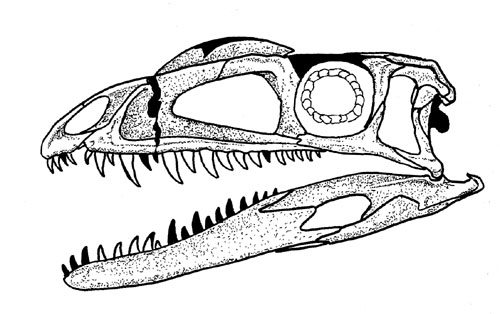
Genus: Nova?
= Syntarsus kayentakatae ROWE, 1989
Etymology: Named in honor of Dr. Kathleen (“Kayenta Kay”) Smith,
who discovered the type specimen and many other important fossils during the
Kayenta Expeditions.
= Megapnosaurus kayentakatae (ROWE,
1989) IVIE, SLIPINSKI & WEGRZYNOWICZ, 2001
Holotype: MNA V2623
Locality: MNA Locality No. 555-3, “Rock Head North” (MCZ field no. 18/78/A, also recorded as “Foxtrot Mesa”), Latitude 35°41’39”, Longitude 111°00’51”W, from a small quarry, now silted-in, on the southwestern side of Sand Mesa, near the Adeii Eechii Cliffs, on Ward Terrace of the Little Colorado River Valley, Arizona.
Horizon: Middle third of the Silty Facies of the Kayenta Formation.
Biostratigraphy:
Age: ?Sinemurian-Pliensbachien Stage, Middle Lias Epoch, Early Jurassic.
Material: Skull and partial postcranial skeleton of a robust adult individual.
Note: Furcula (TYKOSKI, FORSTER, ROWE, SAMPSON & MUNYIKWA, 2002).

Referred material:
Number: Not given: Portions of 2 right femora, in addition to that of the type specimen. A crushed, weathered snout with mandibles, a maxillary fragment with 9th-11th teeth, isolated separate right and left frontals, a partial occipital condyle, 2 fragmentary right femora, isolated proximal ends of 1 right and 2 left tibiae, distal ends of right and left fibulae, isolated distal ends of right and left tibiae with fused astragalocalcaneum and 8 isolated ends of metatarsal.
Note: TYKOSKI, 1998 states…Also catalogued under MNA V2623 are the badly weathered remnants of at least two other individuals collected from the type quarry. These specimens are not very informative. The remains are fragmentary and most were found as surface float on and around the site. The rostral portion of a skull was recovered. Partially complete premaxillae, maxillae, dentaries, and lachrymals are present in this skull…
TYKOSKI, 1998
TMM Field number TR 97/12: Complete pelvis, sacrum, femur, ankles and some vertebrae.
Locality: MNA 219-0, “Rock Head”, Rock Head Quadrangle, Arizona.Horizon: Kayenta Formation.
Biostratigraphy:
Age: ?Sinemurian-Pliesbachian Stage, Middle Lias Epoch, Middle Early Jurassic.
Material:
MNA V100: A partial left ilium with the supra-acetabular crest.
MNA V140: Weathered fragments of a femur and humerus of a presumed juvenile.